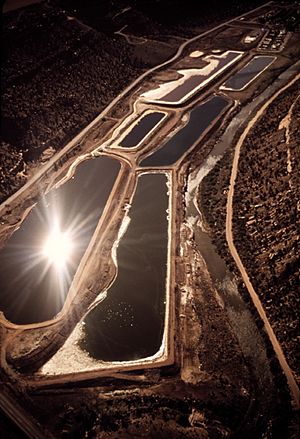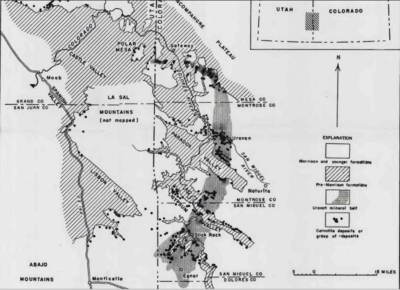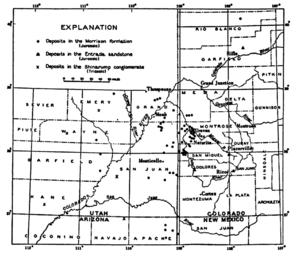Uranium mining in Colorado facts for kids
Uranium mining in Colorado has a long history, starting way back in 1872. That's when a special rock called pitchblende, which contains uranium, was first found in gold mines near Central City, Colorado. The business of digging for uranium in Colorado has had its ups and downs, but it's still going on today. Colorado actually has the third largest amount of uranium underground in the United States, after Wyoming and New Mexico.
Between 2001 and 2007, the price of uranium went up a lot. This made many companies want to start uranium mining in Colorado again. But then, the prices dropped in 2008, and some companies had to stop or slow down their mining plans. Right now, there are no uranium mines actively digging in Colorado.
Contents
Uranium in the Front Range Mountains
You can find uranium in different spots along the Front Range of the Rocky Mountains. These areas include Larimer, Boulder, Gilpin, Clear Creek, and Jefferson counties.
The very first time uranium was found in the USA was in 1871. It was pitchblende from a gold mine in Central City, Colorado. Other mines nearby also found this special rock. From 1872 to about 1916, miners shipped out about 55,000 kilograms of uranium oxide from six gold mines in the Central City area.
After 1940, there was a big demand for uranium. This made people start looking for it again in the old gold and silver mines of the Front Range. Some uranium was found, but the amounts were small. In 1948, pitchblende was found in the Caribou silver mine near Caribou, Boulder County. A small amount of uranium was dug up there.
In 1949, a janitor and part-time explorer named Fred Schwartzwalder found uranium. He found it at an old copper mine in Jefferson County. This was about 16 kilometers northeast of Central City. The uranium was in veins, which are like cracks in the rock. These veins were filled with pitchblende and other minerals. Fred couldn't get anyone interested in his find, so he started digging the mine himself. He made his first shipment of ore in 1953 and sold the mine in 1955. This mine, called the Schwartzwalder mine, produced most of the uranium from the Front Range. It operated until 1995, digging up 7,700 metric tons of uranium oxide. The company that owns it, General Atomics, thinks there's still a lot more uranium there.
Another mine, the Copper King mine in Larimer County, also had uranium. It was about 40 kilometers northwest of Fort Collins. People tried to mine zinc there in the past, but it didn't work out. In 1949, explorers found uranium at the abandoned mine. It was mined for uranium from 1951 to 1953. The uranium was pitchblende found in cracks in old Precambrian granite rock.
Other places in the Front Range where uranium was mined include the Fairday A. M. mine near Jamestown and the Wright Lease mine near Ideledale.
Uravan Mineral Belt
The Uravan mineral belt is a long, curved area about 110 kilometers long. It's found in San Miguel, Montrose, and Mesa counties in Colorado, and also in Grand County, Utah. This area was the most active place for uranium mining in the United States in the early 1900s. It includes mining areas like Slick Rock, Gypsum Valley, Uravan, and Gateway.
Uranium mining in southwest Colorado began in 1898. A miner dug up about 10 tons of yellow rock that had a lot of uranium and vanadium. This was at Roc Creek in Montrose County, Colorado. He sent it to France, where scientists identified a new mineral called carnotite. At first, this mineral was mined for its vanadium, and uranium was just a side product.
Even though radium was found in 1898, people didn't know if carnotite had radium in it until 1911. Scientists at Marie Curie's lab in Paris confirmed it. Even though there was only a tiny bit of radium in the rock, it was very valuable. This was because new medical uses for radium had been found. Radium was worth about $100 per milligram, which made it much more valuable than the vanadium or uranium in the rock.
Once people knew carnotite had radium, many explorers rushed to the Colorado Plateau. They found carnotite in sandstones in Mesa, Montrose, and San Miguel counties in Colorado. At first, the carnotite was sent to Europe to be processed. But by 1913, the Standard Chemical Company built a radium processing plant in Montrose County. It became the biggest supplier of radium in the world.
From 1910 to 1922, the Uravan mineral belt supplied about half of the world's radium. Vanadium and uranium were just extra products. The mines had to close in 1923 because new, rich radium deposits were found in the Belgian Congo. This made the price of radium drop. Mining started again in 1935 when the price of vanadium went up. It really boomed after World War II when the government needed a lot of uranium for nuclear weapons.
The Uravan mineral belt had the last uranium mine to operate in Colorado. It was called the Topaz Mine, near Uravan, Colorado. It closed on March 18, 2009, because uranium prices were too low.
Energy Fuels Inc. wants to reopen the Torbyn mine. This used to be a uranium mine in Mesa County, near Gateway. They are asking for permission to start digging there again.
South Park Area
In 1903, explorers looked at copper-stained sandstone near Garo in Park County. But there wasn't enough copper to mine. In 1919, they found that the sandstone also had uranium and vanadium. About 40 tons of rock with up to 1% uranium were dug from underground. The mine reopened in 1951 as an open-pit uranium mine and closed in 1952. The rocks contained uranium-vanadium minerals like tyuyamunite and carnotite. These were found in a rock formation called the Maroon Formation.
A company called Horizon Nevada Uranium Inc. planned to drill for uranium in the South Park Ranch area in 2008.
Cochetopa Mining Area
The Cochetopa mining area is about 32 kilometers southeast of Gunnison. Uranium was found there in rocks called the Morrison Formation. The uranium is in veins, which are cracks in the rock, along with other minerals like pitchblende. Mining started there in 1954, with underground tunnels.
Marshall Pass Area
Uranium was found near Marshall Pass in 1955. This area is in Saguache and Gunnison counties. At first, the finds weren't big enough to be worth mining. But they led to more searching, and bigger deposits were found. These deposits are about six miles east of Sargents. The uranium is mostly pyrite and pitchblende that replaced older rocks. Some uranophane and autunite are also there. Mining started with small open pits, and later, underground mines were built.
Maybell Mining Area
The Maybell area in Moffat County was found in 1954 using a plane that could detect radiation. Uranium was found there in sandstones of the Miocene Browns Park Formation. The uranium was found near faults, which are thought to have helped the uranium get into the rocks. Rock was dug from many open-pit mines between 1953–1964 and 1976–1981. These mines were north of US Highway 40, between Maybell and Lay. The rocks were processed at a local mill near Maybell. Later, from 1976–1981, the uranium was taken out using a special liquid, and then trucked to Wyoming. This area produced about 2,400 metric tons of uranium oxide.
Tallahassee Creek Area
In 1954, high radiation levels on the surface led to uranium discoveries at Tallahassee Creek in Fremont County. Mining in the 1950s used both underground and open-pit methods.
In the 1970s, companies found two large uranium deposits there. One was estimated to have 12 million pounds of uranium oxide, and the other about 1 million pounds. The uranium is found in sandstones and other sediments. It's often found with carbon and pyrite. The uranium is thought to have come from a volcanic rock formation called the Wall Mountain Tuff.
In 2006, an Australian company bought the rights to mine the Taylor Ranch property. This property has a large uranium deposit that was found in the 1970s but left alone because uranium prices were low. The company plans to drill a lot in 2008 to figure out how much uranium is there.
Denver Basin Area
Small amounts of uranium have been mined from the Dakota Sandstone along the western edge of the Denver Basin. The Mann mine, near Morrison, Colorado, produced about 7.1 metric tons of uranium oxide from 1955 to 1961. The Mike Doyle mine produced a small amount in 1955. Another mine in Larimer County also produced some uranium and vanadium in 1955.
The Leyden coal mine, north of Golden, Colorado, produced about 2.1 metric tons of uranium oxide from 1954 to 1956. This was a side product of coal mining.
In 1969, a rancher named Solomon Schlagel found uranium in Weld County, Colorado. He noticed that dirt from drilling was radioactive. In the 1970s, explorers found several "roll-front" uranium deposits in the Laramie Formation and Fox Hills Formation in Weld County. These are all along the southern edge of the Cheyenne sub-basin of the Denver Basin.
From 1977 to 1978, a company successfully used a method called in-situ leaching to get uranium from a deposit near Grover. This method uses liquids to dissolve the uranium underground. After mining, the water underground was cleaned up.
In 1980, another company started using in-situ mining at Keota, Colorado. This deposit was thought to have 2,300 to 4,500 metric tons of uranium oxide. But the project stopped because uranium prices were too low.
Centennial Project
In 2006, a company called Powertech (USA) Inc. bought the rights to the Centennial Project in Weld County, near Nunn, Colorado. This area had been explored in the 1970s. Powertech is now looking into using in-situ leaching there. This method uses a liquid with dissolved carbon dioxide and oxygen to get the uranium.
The uranium is in "roll fronts" in sandstones of the Fox Hills Formation. These deposits stretch about 18 kilometers from north to south. A consultant for Powertech believes there are about 4,400 metric tons of uranium oxide that can be recovered. There might be even more.
Powertech hopes to get permits by the end of 2009. Then, they plan to extract about 360 metric tons of uranium per year for ten years. The uranium would be taken out of the liquid using special beads. These beads would then be trucked to another facility to get the uranium out. The mining would move from north to south, and the land would be cleaned up after each section is mined.
Some groups, like Coloradoans Against Resource Destruction, are against Powertech's mining plans. They are worried because the Fox Hills Formation is an important source of water for the area.
Environmental Concerns
There are three former uranium mill sites in Colorado that are now on the United States Environmental Protection Agency's list of top cleanup sites (called Superfund sites):
- The Denver Radium Site in Denver.
- Lincoln Park, next to the Cotter Corporation uranium mill near Canon City. The U.S. Environmental Protection Agency is overseeing the cleanup of waste from past operations. The mill still has a license to process uranium.
- The Uravan Uranium Project, at the old town of Uravan.
Also, there are 15 sites in Colorado that are part of the Uranium Mill Tailings Remedial Action (UMTRA) program. These are managed by the United States Department of Energy. Eight of these sites are old uranium ore mills, and seven are special places where the mill waste is stored permanently.
Current Uranium Mining
There are some active uranium mines in Colorado in the Ivan belt. One active uranium mine in the state is the Sunday mine near Uravan, which is owned by Denison Mines.
In 2007, Energy Fuels Inc. announced plans to build a new mill in the Uravan district, west of Naturita. If built, this would be the first new uranium mill in the United States in 25 years. The US Bureau of Land Management has given permission for Energy Fuels to start mining at its Whirlwind mine in Mesa County, Colorado. This mine is expected to produce about 113 metric tons of uranium oxide each year.
A Canadian company, Powertech (USA) Inc., is looking into uranium deposits in its Centennial Project in Weld County. Because of these mining plans, lawmakers in Colorado have suggested two new rules. The first would require mining companies to prove that underground water won't be harmed before they can start mining. The second would make sure that local governments can set their own health and environmental rules for mining.





